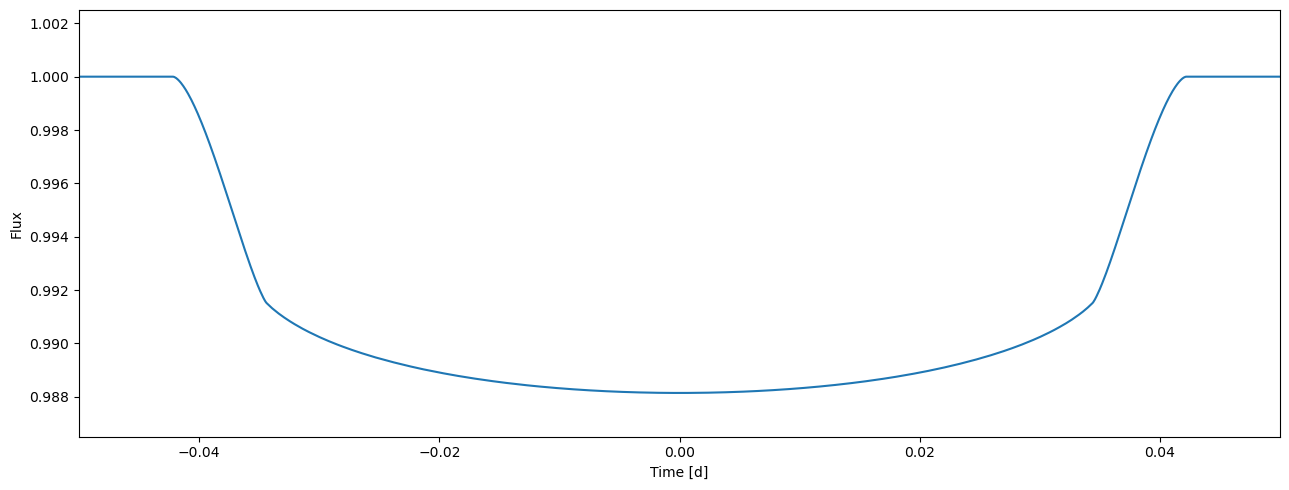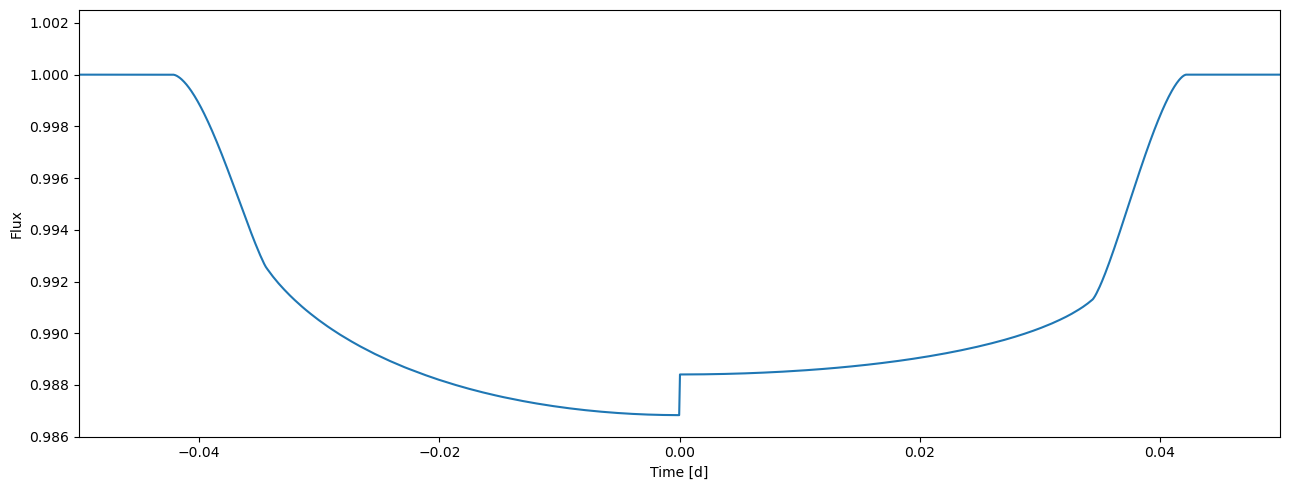RoadRunner transit model example III - LDTk-based limb darkening#
Author: Hannu Parviainen Last modified: 23 April 2024
The LDTk limb darkening model, pytransit.LDTkLDModel (or just LDTkM), works as an example of a more complex limb darkening model that is best implemented as a subclass of pytransit.LDModel. The LDTk limb darkening model uses LDTk to create a set of stellar limb darkening profile samples given the stellar  ,
,  , and metallicity with their uncertainties, and uses the profiles directly to calculate the transit. The
profiles are created from the PHOENIX-calculated specific intensity spectra by Husser (2013), and the model completely avoids approximating the limb darkening profile with an analytical function.
, and metallicity with their uncertainties, and uses the profiles directly to calculate the transit. The
profiles are created from the PHOENIX-calculated specific intensity spectra by Husser (2013), and the model completely avoids approximating the limb darkening profile with an analytical function.
This notebook shows how to use LDTkM with RoadRunner, but the main use case for the model is in transmission spectroscopy when combined with the pytransit.TSModel transmission spectroscopy transit model. This is because, when using LDTkLDModel, The limb darkening model is always evaluated using ( ,
,  , and metallicity), and the number of limb darkening parameters is independent of the number of passbands. This makes it especially useful for transmission
spectroscopy where you may need to model tens of passbands simultaneously.
, and metallicity), and the number of limb darkening parameters is independent of the number of passbands. This makes it especially useful for transmission
spectroscopy where you may need to model tens of passbands simultaneously.
[1]:
%matplotlib inline
from matplotlib.pyplot import plot, subplots, setp
from matplotlib import rc
from numpy.random import normal, uniform
from numpy import arange, array, ndarray, linspace, pi, repeat, tile, zeros
rc('figure', figsize=(13,5))
[2]:
def plot_lc(time, flux, c=None, ylim=(0.9865, 1.0025), ax=None, alpha=1):
if ax is None:
fig, ax = subplots()
else:
fig, ax = None, ax
ax.plot(time, flux, c=c, alpha=alpha)
ax.autoscale(axis='x', tight=True)
setp(ax, xlabel='Time [d]', ylabel='Flux', xlim=time[[0,-1]], ylim=ylim)
if fig is not None:
fig.tight_layout()
return ax
Import the model#
First, we import the RoadRunnerModel and LDTkLDModel and some simple transmission functions from LDTk.
[3]:
from pytransit import RoadRunnerModel, LDTkLDModel
from ldtk import sdss_g, sdss_r, sdss_i, sdss_z
[4]:
time = linspace(-0.05, 0.05, 1500)
Example 1: single passband#
The LDTkLDModel is initialised by giving it the stellar parameters and passband transmission functions,
[5]:
ldm = LDTkLDModel(teff=(5500, 150), logg=(4.5, 0.1), metal=(0.0, 0.1), pbs=[sdss_i], dataset='visir-lowres')
and given to the RoadRunnnerModel as any other limb darkening model.
[6]:
tm = RoadRunnerModel(ldm)
tm.set_data(time)
after which the transit model evaluation goes as usual
[7]:
flux1 = tm.evaluate(k=0.1, ldc=[5205, 4.47, 0.03], t0=0.0, p=1.0, a=4.2, i=0.5*pi, e=0.0, w=0.0)
[8]:
plot_lc(time, flux1);

Example 2: multiple passbands#
[9]:
ldm = LDTkLDModel([sdss_g, sdss_z], teff=(5500, 150), logg=(4.5, 0.1), metal=(0.0, 0.1), dataset='visir-lowres')
[10]:
lcids = zeros(time.size, int)
lcids[time.size//2:] = 1
[11]:
tm = RoadRunnerModel(ldm)
tm.set_data(time, lcids=lcids, pbids=[0,1])
[12]:
flux1 = tm.evaluate(k=0.1, ldc=[5205, 4.47, 0.03], t0=0.0, p=1.0, a=4.2, i=0.5*pi, e=0.0, w=0.0)
[13]:
plot_lc(time, flux1, ylim=(0.986, 1.0025));

©2024 Hannu Parviainen